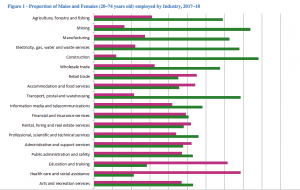Given the construction sector’s imminent skills shortage, it’s hard to understand why there are still so many barriers for women entering, and remaining, in the industry.
The Australian Bureau of Statistics (ABS) has recently released research on gender participation within the construction industry. Well known for being the most male-dominated industry in Australia, the disparity is significant, particularly when it comes to management roles. The results reveal that a whopping 97 per cent of all CEOs and 88 per cent of senior managers in the industry are men.
When it comes to pay equality, construction doesn’t fare much better. It comes in a close second to the finance sector for having the highest pay gap between genders.
Courtney Warren from Queensland knows first hand what it’s like to be in the minority—she was the only female in a class of 30 during her pre-apprenticeship course. Courtney told Jobsite ANZ that in her case, confidence was key to being a successful electrician.
“Being a tradie is presented by society as something males should do. But that’s not true. It’s a perfectly viable career for a female. I think that confidence is a key factor to ‘survival’ as a female tradie and is somewhat just as important as trade skills. You need to be prepared because you’ll get questions every time you knock on a new client’s door.”
Warren says she is often asked why she chose to become an electrician, a question her male counterparts rarely hear.
Being a tradie is presented by society as something males should do. But that’s not true. It’s a perfectly viable career for a female.
Straight out of high school, Warren travelled for two years before returning home only to realise an office job was not for her. A trade seemed a logical solution.
“I thought that being an electrician seemed like a mentally challenging, and possibly good-paying trade, so I applied for apprenticeships.”
When asked if she ever felt intimidated by a male coworker, Warren said she has felt what she would describe as social intimidation.
“I think that people assume female electricians get sexist comments or have to put up with bullying at work, but it’s kind of the opposite. Male coworkers are so afraid they’re going to have a ‘sexual harassment lawsuit’ that they won’t approach me. They won’t be as friendly with me as they might with a male employee. So it’s up to me to be confident to bridge that gap.”
Warren believes that one of the biggest barriers for women is that no one treats them as equally competent as their male colleagues. They’re judged by their coworkers, clients and even employers.
Other issues the industry has yet to address is a poor choice of workwear dedicated to female construction workers.
“Stores have only just started selling female steel cap boots in recent years, and most of my workwear comes from the men’s sections,” said Warren.
Amanda Bulow, Founder & Chairperson of Awesome Women in Construction, AWIC, talked to Jobsite about her experience with the barriers women are experiencing.
“Realising their own self-confidence and self-worth is the real issue. I see many women in the industry who are leading the way for the next generation, and they just can’t see the enormous value they are adding to the industry. We are trying to change this via workshops and providing a supportive community at AWIC.”
AWIC hopes to reach out to young women as early as high school so they could find out about the exciting career opportunities available for them in the construction field.
Bulow says the industry still needs to implement improvements to study options. As an example, one member of AWIC is currently undertaking studies, but the TAFE she was attending had inadequate nighttime lighting at the campus. There were also no female toilets in the building where the trade classes were held. This member has opted for completing her studies at home because she felt unsafe and undervalued as a colleague in the construction industry.
Bulow would like to see more female role models in the industry, particularly in teaching roles.
“We have some amazing and talented women in the construction industry who could teach a Cert IV in Construction and/or a Project Management course. Why are we not supporting this?”

Photo courtesy of Australian Bureau of Statistics – 4125.0 – Gender Indicators, Australia, Sep 2018
The ABS shared some interesting insights around the study outcomes of men and women. According to the data released, unsurprisingly, women were least likely to have qualifications in Architecture and building. In fact, the sector accounted for just 1 per cent of all female graduates each year between 2007 and 2017, whereas men were ten times more likely to have qualifications in this field.
Although statistics show that while women were far less likely to study Architecture and building or Engineering than men, they tended to study at higher levels once they chose this field. In 2017, 42 per cent of women with a qualification in Architecture and building had a Bachelor degree as their qualification and 17 per cent had a Postgraduate Degree, compared to 8 per cent and 1 per cent of men, respectively. When it comes to Engineering, 39 per cent of women had a Bachelor Degree and 11 per cent had a Postgraduate Degree as their qualification, compared to 17 per cent and 4 per cent of men, respectively.
If you liked this article, here are a few eBooks, webinars, and case studies you may enjoy:
Building Empathy – Understanding the diversity of different generations in the workplace
Leave a Reply